Impact of Cross‑Chain Aggregators on Gas Fees and Transaction Efficiency


Imagine trying to transfer digital assets but feeling like you're stuck in a labyrinth of endless tolls and confusing shortcuts. In today's blockchain ecosystem, fragmented across a multitude of Layer‑1 and Layer‑2 networks, users often face exorbitant gas fees and convoluted transfer processes. Enter cross‑chain aggregators: ingenious solutions that unite bridges and decentralized exchanges (DEXs) to clear the path for smoother, more efficient transactions. In this article, we explore their inner workings, benefits, challenges, and the exciting future potential they hold.
What are cross‑chain aggregators, and how do they work?
To appreciate their full value, it’s essential to understand what cross‑chain aggregators are and how they automate multi‑step transfers for users. These innovative tools act as the ultimate connectors between different blockchains, enabling seamless, efficient asset transfers across networks. Rather than relying on manual processes or interacting with multiple platforms, cross‑chain aggregators streamline the entire experience by enabling users to move assets effortlessly between different chains, whether EVM, Solana, Bitcoin or any other blockchain.
Cross‑chain aggregators simplify decentralized finance (DeFi) by optimizing transfers, cutting down gas fees, and reducing transaction delays. They enhance the user experience by automating complex processes and creating a frictionless bridge across blockchain ecosystems, making DeFi more accessible and efficient for everyone.
Mechanism
Cross‑chain aggregators connect bridges, decentralized exchanges (DEXs) through a routing engine. Let’s break it down: when a user wants to swap ETH on Ethereum for USDT on Solana, they simply input their asset and target chain into the protocol. Behind the scenes, the aggregator manages the transaction across multiple bridges and DEXs, optimizing the path to ensure the best possible rate and minimal fees.
The process is seamless and efficient, with users not needing to manually interact with different platforms. Smart routing ensures that the transaction is completed in one smooth operation, without the user even realizing how many different systems were involved. This combination of smart automation and liquidity aggregation allows for quicker, cheaper, and more reliable cross-chain transfers.
Why Cross‑Chain Aggregators are essential for seamless crypto transactions?
With the growth of blockchain networks, users face increasing challenges, fragmented liquidity, multiple protocols, and manual bridging. Cross‑chain aggregators solve these issues by simplifying asset transfers across different chains, offering a faster, more cost-effective, and frictionless experience.
Benefits
How aggregators optimize gas fees across blockchains?
One of the most compelling advantages of cross‑chain aggregators is gas fee optimization, crucial as Ethereum fees fluctuate dramatically.
Smart routing & batching
Aggregators optimize trade execution by selecting cost-effective routes, intelligently managing orders to avoid high-fee liquidity pools, and combining multiple steps into a single transaction to reduce overhead. In the realm of cross-chain transfers, platforms like Across have demonstrated substantial gas savings, reportedly consuming significantly less gas than comparable bridges on Ethereum, with reductions reaching up to 80%. Additionally, capital efficiency strategies are gaining traction as a means to lower transaction costs, potentially reducing them by 25% to 75%.
Smart contracts & rollups
Advanced aggregators enhance efficiency by deploying highly optimized smart contracts designed to minimize unnecessary on-chain operations. They also leverage Layer-2 rollups, which bundle multiple transactions off-chain and settle them on-chain as a single batch, significantly reducing the number of on-chain opcodes executed. This dual approach contributes to noticeably lower gas consumption and improved overall performance.
Enhancing transaction efficiency with cross‑chain aggregators
Efficiency isn't only about cost, it's timing, reliability, and user experience. Aggregators deliver on all fronts.
Faster Settlement & Reliability
Aggregators streamline the entire process of swaps and cross-chain bridges by executing them within a single smart contract flow. This eliminates the need for users to manually perform multiple steps across different chains or interfaces. As a result, latency is reduced, and potential failure points are minimized, leading to faster settlement times and more reliable transaction execution.
Improved Performance Metrics
Modern aggregators are increasingly evaluated based on critical performance indicators such as latency, throughput, and operational overhead during cross-chain swaps. By bundling multiple sub-transactions into a unified process, aggregators not only reduce computational waste but also enhance compliance, boost processing speeds, and maintain trustless execution standards, making them well-suited for high-performance blockchain environments.
Broader Utility
The capabilities of aggregators extend far beyond simple token swaps. They serve as infrastructure for more complex use cases, including cross-chain yield farming, DAO treasury reallocations, NFT migrations across ecosystems, and active participation in GameFi applications. This broader utility allows users and developers to tap into multi-chain value streams seamlessly from a single interface.
Challenges and future potential of cross‑chain aggregators
Though promising, cross‑chain aggregators face hurdles: security, latency, liquidity, and regulatory complexity.
Challenges
Future Potential
Conclusion
Cross‑chain aggregators represent a transformative upgrade for blockchain users: slashing gas fees, boosting speed, simplifying UX, and enabling seamless multichain finance. Supported by smart routing, batching, and optimized contracts, they’re the logical next step in DeFi and Web3 evolution. Despite hurdles in security and regulation, advances like AI routing and zk‑proofs signal a future rich with opportunity, where moving assets across chains becomes as easy as a single click.
Resources
Frequently asked questions
Check out most commonly asked questions, addressed based on community needs. Can't find what you are looking for?
Contact us, our friendly support helps!
Can cross‑chain aggregators guarantee the lowest gas fees every time?
They use real-time routing and batching to minimize gas, but guarantees vary based on liquidity and network congestion.
Are cross-chain aggregators secure?
While many use secure bridges and audits, vulnerabilities persist. Advanced mechanisms like zk‑proofs and fallback logic are essential for safety.
Can I integrate aggregator functionality into my dApp?
Yes, protocols like Rango offer SDKs and APIs for seamless integration, enabling less development overhead and broader chain support.




